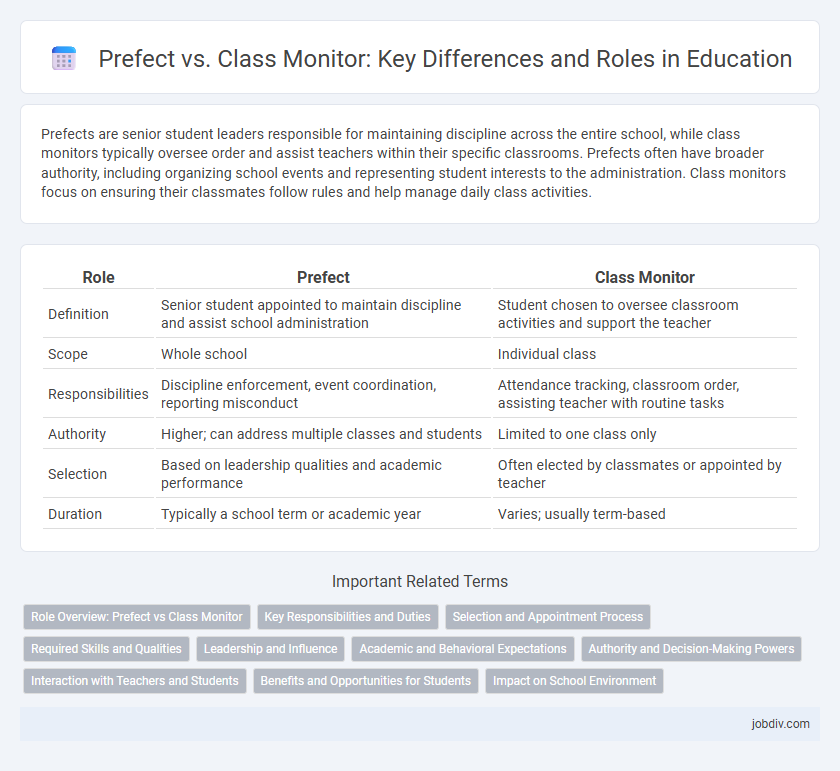Prefects are senior student leaders responsible for maintaining discipline across the entire school, while class monitors typically oversee order and assist teachers within their specific classrooms. Prefects often have broader authority, including organizing school events and representing student interests to the administration. Class monitors focus on ensuring their classmates follow rules and help manage daily class activities.
Table of Comparison
| Role | Prefect | Class Monitor |
|---|---|---|
| Definition | Senior student appointed to maintain discipline and assist school administration | Student chosen to oversee classroom activities and support the teacher |
| Scope | Whole school | Individual class |
| Responsibilities | Discipline enforcement, event coordination, reporting misconduct | Attendance tracking, classroom order, assisting teacher with routine tasks |
| Authority | Higher; can address multiple classes and students | Limited to one class only |
| Selection | Based on leadership qualities and academic performance | Often elected by classmates or appointed by teacher |
| Duration | Typically a school term or academic year | Varies; usually term-based |
Role Overview: Prefect vs Class Monitor
Prefects hold a broader leadership role within the entire school, responsible for maintaining discipline, assisting staff, and representing students during official functions, often selected through a formal process. Class Monitors focus on managing classroom activities, ensuring attendance, and acting as a liaison between students and teachers, typically appointed by the class teacher. Both roles emphasize leadership and responsibility but differ in scope, with prefects overseeing school-wide order and monitors concentrating on individual class management.
Key Responsibilities and Duties
Prefects are student leaders entrusted with maintaining overall discipline, organizing school events, and assisting teachers in administrative tasks, often overseeing multiple classes or whole school areas. Class monitors primarily manage classroom-specific duties such as taking attendance, ensuring classroom cleanliness, and acting as a liaison between students and teachers. Both roles promote responsibility and leadership but differ significantly in scope and authority, with prefects holding broader school-wide responsibilities.
Selection and Appointment Process
Prefects are typically selected through a combination of teacher recommendations, student leadership qualities, and academic performance, often involving a formal interview or voting process by staff and peers. Class monitors, on the other hand, are usually appointed by the class teacher based on punctuality, discipline, and reliability within the classroom setting. The selection process for prefects tends to be more competitive and comprehensive, emphasizing leadership skills and responsibility across the entire school.
Required Skills and Qualities
Prefects require strong leadership, discipline, and conflict resolution skills to maintain school order and represent the student body effectively. Class monitors need organizational abilities, attentiveness, and communication skills to assist teachers and ensure classroom discipline. Both roles demand responsibility, reliability, and a positive attitude to foster a productive learning environment.
Leadership and Influence
Prefects hold broader leadership responsibilities, often involving school-wide discipline, event coordination, and serving as role models for the entire student body. Class monitors focus primarily on managing classroom order, assisting teachers with administrative tasks, and influencing peers within their specific class. The leadership impact of prefects extends beyond a single group, promoting a cohesive school environment, while class monitors cultivate influence and responsibility on a smaller, more localized scale.
Academic and Behavioral Expectations
Prefects are senior student leaders entrusted with maintaining overall discipline and upholding school rules across various domains, including academic integrity and behavioral standards. Class monitors primarily assist teachers by managing classroom order, ensuring punctuality, and promoting a focused learning environment directly linked to academic performance. Both roles demand responsibility, but prefects have broader authority to enforce behavioral expectations school-wide, while class monitors focus on supporting academic routines within their specific class.
Authority and Decision-Making Powers
Prefects typically hold greater authority and decision-making powers than class monitors, often overseeing broader disciplinary responsibilities across multiple classes or the entire school. While class monitors primarily manage classroom-specific tasks such as attendance and student behavior, prefects can enforce school-wide rules and assist in administrative decisions. Their elevated role often includes representing the student body in meetings with school staff, reflecting a higher level of trust and responsibility.
Interaction with Teachers and Students
Prefects often have a more formal role in interacting with teachers, serving as intermediaries for maintaining discipline and organizing school activities, while class monitors focus on day-to-day class management and direct communication with both teachers and students. Prefects usually represent the broader student body and liaise with school authorities, enhancing overall school governance. Class monitors maintain classroom order, assist teachers with administrative tasks, and foster peer cooperation within their specific class.
Benefits and Opportunities for Students
Prefects and class monitors provide distinct benefits and opportunities that enhance student leadership development and responsibility. Prefects often manage school-wide initiatives, fostering skills in organization, communication, and conflict resolution, while class monitors focus on maintaining classroom order and supporting teachers, building teamwork and accountability. Both roles empower students to develop confidence and leadership capabilities essential for future academic and professional success.
Impact on School Environment
Prefects foster discipline and uphold school rules, creating a structured and respectful learning atmosphere. Class monitors facilitate communication between students and teachers, enhancing classroom management and student engagement. Both roles contribute significantly to a positive and orderly school environment by promoting responsibility and teamwork among students.
Prefect vs Class Monitor Infographic

 jobdiv.com
jobdiv.com